
Science Update Podcast - Daily Edition
Science Update Podcast - Daily Edition
The Science Radio News Feature of the AAAS
- 1 minuteCreative Dreaming
TRANSCRIPT
BOB HIRSHON (host):
Dreaming up answers. I’m Bob Hirshon and this is Science Update.
Many creative thinkers, including artists, musicians and scientists, report getting new insights through dreams. Harvard clinical psychologist Deirdre Barrett studies creative dreaming, and has found that t he dreaming brain specializes in visual-spatial solutions.
BARRETT:
Problems that start off as visual always get solved in a straightforward visual way in the dream, but things that are more of a word problem or math problem often get represented in images, because that seems to be the part of the mind that’s most active during dreaming.
HIRSHON:
She says dreams also excel at solving problems requiring outside the box thinking, probably because our prefrontal cortex—the part of the brain that filters out ideas that are silly or inappropriate—is quiet during sleep, allowing unusual ideas to surface. She says visualizing a problem before going to sleep, and having paper, pen and a flashlight on a bedside table frequently yields valuable new insights. I’m Bob Hirshon, for AAAS, the science society.
MORE INFO
If you want to hear Dr. Barrett discuss sleep in detail, check out this podcast on the Science of Dreaming from the American Psychological Association:
A study titled Increased Creative Thinking in Narcolepsy looks at creativity in patients with narcolepsy, a condition characterized by a sudden onset of REM-stage sleep. Since creativity has been associated with this stage of sleep, the authors wanted to see if narcolepsy patients were more creative than a control group.
Researchers are also looking at the effects of daytime napping on different types of creativity.
And this study looks at our ability to enhance the creativity-boosting qualities of our sleep.
The post Creative Dreaming appeared first on Science Update.
4 November 2018, 4:30 am - 1 minuteRobot Gaze Aversion
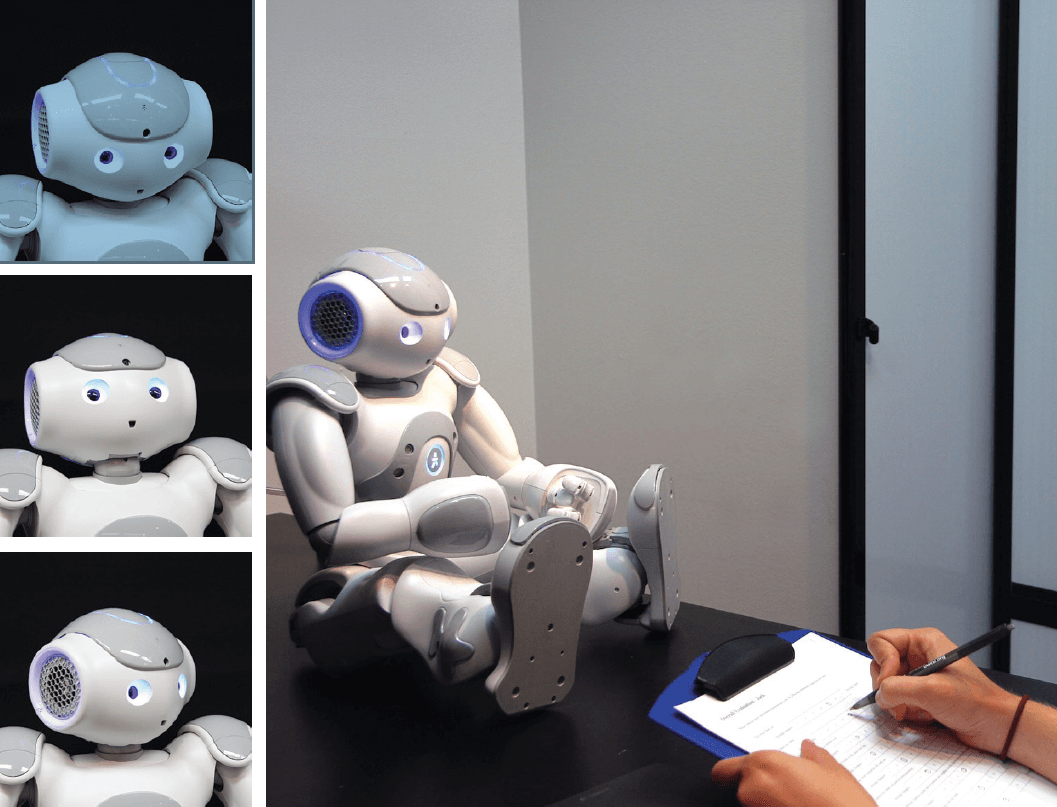
BOB HIRSHON (host):
Refining robot social skills. I’m Bob Hirshon and this is Science Update.
Making eye contact is an important social skill, but so is occasionally breaking eye contact. That’s true for robots as well. Bilge Mutlu is a professor of computer science, psychology, and engineering at the University of Wisconsin, Madison. His team found that humans were most comfortable talking to robots that glanced away in typical human patterns: to signal the other person’s turn to speak, for example.
BILGE MUTLU (University of Wisconsin, Madison):
People don’t interrupt the robot when it’s averting its gaze. And both when no aversion, or, sort of badly timed aversions happen, people are more likely to interrupt the robot, they think the robot’s not as thoughtful, and they don’t think that the robot’s behaviors are intentional.
HIRSHON:
Next, Mutlu says he’d like to teach robots more sophisticated gaze aversion habits: for example, making them respond to changes in eye contact from their human partners. I’m Bob Hirshon for AAAS, the Science Society.——————————
This research was a project of the Human-Computer Interaction Laboratory at the University of Wisconsin–Madison, co-led by Professors Bilge Mutlu and Michael Gleicher, and carried out by graduate student Sean Andrist and undergraduate student Zhi Tan.
The post Robot Gaze Aversion appeared first on Science Update.
2 November 2018, 4:55 am - 1 minuteBombardier Beetle Buddies
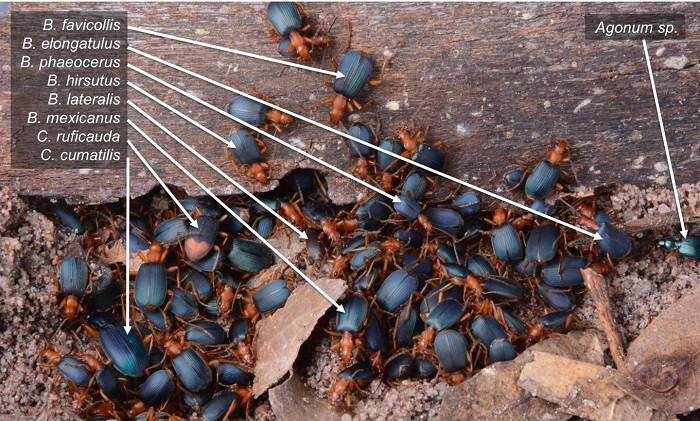 Multispecies aggregation. (Schaller et al., 2018 CC-BY)
Multispecies aggregation. (Schaller et al., 2018 CC-BY)BOB HIRSHON (Host):
Bombardier beetle buddies. I’m Bob Hirshon and this is Science Update.
Bombardier beetles are bright blue and red, which helps to advertise their fierce defensive arsenal: burning hot toxic chemicals they can spray from nozzles on their butts. In the journal PLOS ONE, University of Arizona entomologist Wendy Moore and her colleagues report that while the nocturnal beetles are solitary at night, many different species shelter together during the day, under rocks.
WENDY MOORE (University of Arizona, Tucson):
It’s actually a fairly unusual phenomenon for different species to regularly associate with one another.
HIRSHON:
One reason could be that the different species bring different toxic weapons.
MOORE:
–that probably contribute to a big chemical cocktail for a vertebrate predator that might find them during the day.
HIRSHON:
And the huge mass of brightly colored beetles could warn would-be predators to back off. I’m Bob Hirshon for AAAS, the science society.
Story by Bob Hirshon
The post Bombardier Beetle Buddies appeared first on Science Update.
1 November 2018, 4:54 am - Seeking Out Fear
 Jim Pennucci/CC BY 2.0, via flickr)
Jim Pennucci/CC BY 2.0, via flickr)BOB HIRSHON (host):
Enjoyable fear. I’m Bob Hirshon and this is Science Update.
Fear and anxiety are negative sensations that people tend to avoid. In fact, they exist to help us avoid threatening situations. So why do we sometimes seek out fear-inducing experiences for fun— especially around Halloween? New York University neuroscientist Joseph LeDoux explains that being thrilled and excited and being terrified share many of the same physiological reponses.
JOSEPH LEDOUX (New York University):
You’ve got adrenaline and noradrenaline being released, and cortisol and all these things are impacting your brain. But in the situation that you’re in, you’re interpreting that in terms of elation or excitement, rather than in terms of something awful happening to you.
HIRSHON:
Of course, adrenaline feels more pleasurable to some people than others; for some, no matter how safe the environment, the negative sensations from viewing a horror movie or riding a roller coaster will outweigh any thrills. I’m Bob Hirshon, for AAAS, the science society.
Story by Bob Hirshon
The post Seeking Out Fear appeared first on Science Update.
31 October 2018, 4:53 am - 1 minuteThe Lyrebird’s Dance
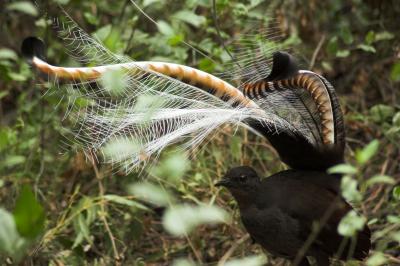 A male superb lyrebird performs his courtship dance and song. (Alex Maisey)
A male superb lyrebird performs his courtship dance and song. (Alex Maisey)BOB HIRSHON (host):
Dancing with the lyrebirds. I’m Bob Hirshon and this is Science Update.
(Lyrebird song)
This might sound like a shoot-’em up arcade game, but it’s really an Australian bird serenading a female. Superb lyrebirds are known for their prodigious vocal talents. But now, scientists have discovered that the males also impress females by pairing each of their courting songs with a particular dance. Australian National University behavioral ecologist Anastasia Dalziell led the study.
ANASTASIA DALZIELL (Australian National University):
When they’re dancing they have just four different songs, and with each of those four songs, the lyrebirds have a unique set of dance movements. So depending on what songs they sing, you can predict what kind of dance moves they’re going to perform.
HIRSHON:
She says as in humans, coordinating dance moves with songs is hard work. So it’s possible that females pick their mates based on their ability to groove. I’m Bob Hirshon, for AAAS, the science society.
Watch a video about superb lyrebird song and dance
For more information about this study, visit: https://dx.doi.org/10.1016/j.cub.2013.05.018
The post The Lyrebird’s Dance appeared first on Science Update.
30 October 2018, 4:36 am - Sea Hare Ink
BOB HIRSHON (host):
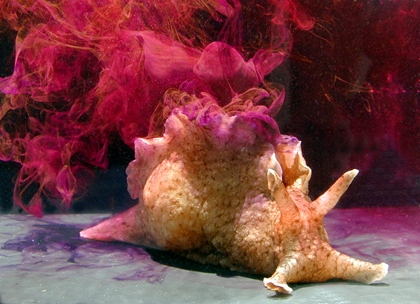 A sea hare exudes colorful ink to ward off predators. (Genevieve Anderson/ Santa Barbara City College)
A sea hare exudes colorful ink to ward off predators. (Genevieve Anderson/ Santa Barbara City College)A colorful defense. I’m Bob Hirshon and this is Science Update.
Sea hares are strange sluglike creatures that live on seaweed in shallow waters. Like squid, they emit a colorful but foul-tasting ink when threatened by predators. But according to Georgia State neuroecologist Charles Derby, the ink contains an amino acid that can actually stimulate a predator’s appetite.
CHARLES DERBY (Georgia State University):
They’ll grab the sea hare; the sea hare will ink, and the predator will drop the sea hare and start eating this ink, and what happens then is that it’s distracted by this, and allows the sea hare to escape. So it’s a pretty cool form of defense.
HIRSHON:
Derby’s research team found that the ink may also scramble the predator’s ability to sense the presence of prey. And he adds that enzymes in the ink have antimicrobial properties, which could be used to treat wounds or combat harmful bacteria. I’m Bob Hirshon, for AAAS, the science society.
The post Sea Hare Ink appeared first on Science Update.
26 October 2018, 4:01 am - Yo-Yo Dieting
BOB HIRSHON (Host):
The ups and downs of yo-yo dieting. I’m Bob Hirshon and this is Science Update.
Many doctors warn that yo-yo dieting, in which people repeatedly cut down on calories and lose weight, but then gain it right back again, is worse than being overweight. But Indiana University researcher David Allison and his colleagues report in the journal Obesity that in mice, such up and down weight cycling improved longevity when compared with mice who didn’t diet at all.
DAVID ALLISON (Indiana University School of Public Health- Bloomington):
So it’s better, at least if you’re an obese mouse, to lose weight, even if you regain that weight, and do it over and over again.
HIRSHON:
Allison says more work will be needed to see whether the same holds true for humans. Since losing and regaining weight is so common in people, he adds that understanding how it affects metabolism, body composition, inflammation and other markers of health is important. I’m Bob Hirshon, for AAAS, the science society.
Story by Bob Hirshon
The post Yo-Yo Dieting appeared first on Science Update.
25 October 2018, 4:59 am - Dad’s Exercise
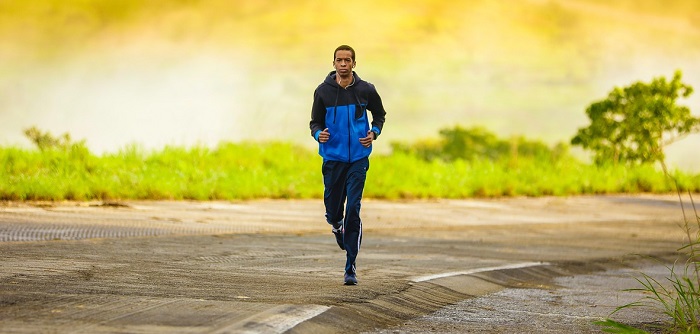 Could exercising improve the health of a man’s future children? (Pixabay)
Could exercising improve the health of a man’s future children? (Pixabay)BOB HIRSHON (Host):
Dad’s exercise might make kids healthier. I’m Bob Hirshon and this is Science Update.
If a male mouse exercises for a few weeks before fathering offspring, those offspring will grow up to be healthier adult mice. This according to Ohio State researcher Kristin Stanford and her colleagues, writing in the journal Diabetes.
KRISTIN STANFORD (Ohio State University Wexner Medical Center):
So essentially, it improved their glucose metabolism, decreased body weight, and increased insulin sensitivity.
HIRSHON:
She said that even though exercise doesn’t change the DNA that the father mouse gives to its offspring, it does change other molecules called small RNAs that control how the DNA is expressed. She suspects the same is true in people.
STANFORD:
The idea would be if you have a dad who wants to have a child, if they could exercise, maybe just a month prior to conception, that would have a really dramatic effect on their child’s life.
HIRSHON:
The researchers are now trying to understand how the small RNAs exert this effect. I’m Bob Hirshon, for AAAS, the science society.
Story by Bob Hirshon
The post Dad’s Exercise appeared first on Science Update.
24 October 2018, 4:49 am - Dog Vocabulary
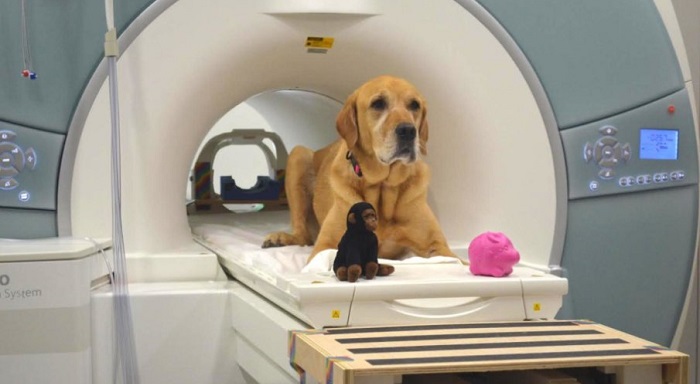 A dog poses in the fMRI scanner with two of the toys used in the experiment. (Gregory Berns, Emory University)
A dog poses in the fMRI scanner with two of the toys used in the experiment. (Gregory Berns, Emory University)BOB HIRSHON (host):
Talking with dogs. I’m Bob Hirshon and this is Science Update.
It often seems like our dogs hang on our every word, but do they really understand human vocabulary? To find out, Emory University neuroscientist Gregory Berns and his team scanned the brains of pet dogs while their owners talked to them. They report in Frontiers in Neuroscience that the dogs’ brains distinguished familiar words associated with favorite toys from words they had never heard before that were paired with random objects.
GREGORY BERNS (Emory University):
What we found was some evidence that at least in half the dogs we could ID regions that seem to represent these objects based solely on the names of them. We see evidence for representation in the temporal lobes, which is also what you see in humans.
HIRSHON:
Berns says while their word discrimination abilities are impressive, your dogs may understand you best when you use simple language combined with hand signals. I’m Bob Hirshon, for AAAS, the science society.
The post Dog Vocabulary appeared first on Science Update.
23 October 2018, 4:45 am - Virtual Reality & Empathy
BOB HIRSHON (host):
Can virtual reality boost empathy? I’m Bob Hirshon and this is Science Update.
Virtual reality technology helps people experience what it’s like to be in someone else’s shoes. This makes them more empathetic, according to a study in the journal PLOS ONE. Stanford psychologist Fernanda Herrera and her colleagues immersed volunteers in a virtual reality experience that simulated homelessness: from facing eviction, to living in a car, and interacting with other homeless people.
FERNANDA HERRERA (Stanford University):
The main takeaway of our study is that taking the perspective of others in VR produced more empathy and pro-social behaviors immediately after the VR experience and better attitudes toward the homeless comparative to a traditional perspective taking task.
HIRSHON:
Herrera says those improved attitudes were long-lasting. She plans to test whether different types of virtual reality foster empathy in other social contexts. I’m Bob Hirshon, for AAAS, the science society.
Story by Susanne Bard
The post Virtual Reality & Empathy appeared first on Science Update.
22 October 2018, 4:47 am - Spreading Viruses
BOB HIRSHON (host):
 The modern office building is a festering cesspool of germs. (Phil Whitehouse/Flickr)
The modern office building is a festering cesspool of germs. (Phil Whitehouse/Flickr)Runaway germs. I’m Bob Hirshon and this is Science Update.
Modern office work has increased the spread of viruses. To find out just how quickly germs move around, University of Arizona environmental microbiologist Charles Gerba and his team put a harmless virus on the doorknobs of office buildings at the beginning of the day.
CHARLES GERBA (University of Arizona):
We were quite surprise by how fast the virus spread. Within four hours it appeared on half the surfaces that people would commonly touch.
HIRSHON:
In fact, he says people’s hands spread viruses around more quickly than sneezing. And in another study, they found that hotel cleaning crews spread germs very efficiently from room to room via the very towels they used to clean with.
GERBA:
If you hear someone coughing in the room next to you, whatever he had will probably be in your room the next night.
HIRSHON:
If that’s enough to make you want to go live under a rock, the good news is, common disinfectant wipes reduced the viruses’ concentration by up to 99%. I’m Bob Hirshon, for AAAS, the science society.
The post Spreading Viruses appeared first on Science Update.
19 October 2018, 4:57 am - More Episodes? Get the App
Your feedback is valuable to us. Should you encounter any bugs, glitches, lack of functionality or other problems, please email us on [email protected] or join Moon.FM Telegram Group where you can talk directly to the dev team who are happy to answer any queries.

 Weekly Show – Science Update
Weekly Show – Science Update
 The Loh Down on Science
The Loh Down on Science
 PNAS Science Sessions
PNAS Science Sessions
 ACS Science Elements
ACS Science Elements
 Science Signaling Podcast
Science Signaling Podcast
 Diffusion Science radio
Diffusion Science radio